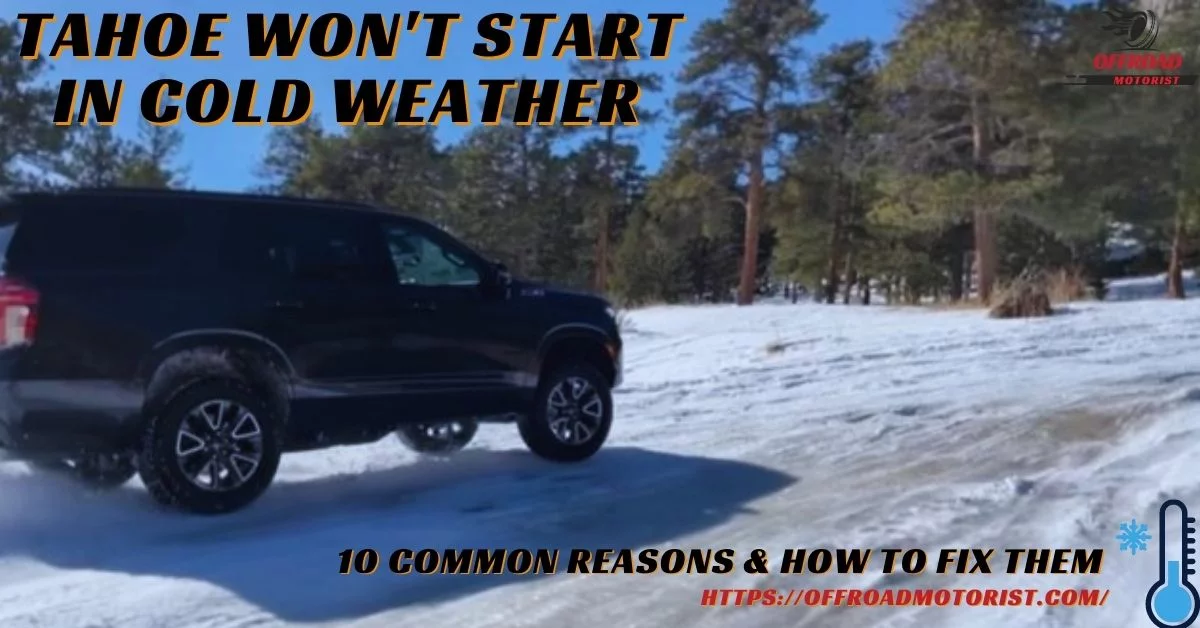Why Your Chevy Tahoe Cranks but Wont Start [Solving the Mystery]
Chevy Tahoe cranks but wont start can be a frustrating and concerning issue for any Chevy Tahoe owner. Not only does it hinder your ability to get from point A to point B, but it can also raise safety concerns if you’re stuck on the side of the road.
Whether it’s a dead battery, faulty alternator, clogged fuel filter, malfunctioning ignition switch, bad starter motor, or engine mechanical issues, we’ve got you covered.
In this blog post, Our comprehensive guide will help you diagnose and fix the problem. With a focus on providing practical solutions and regular maintenance tips, this blog post is your go-to resource for getting your Chevy Tahoe back on the road.
Common Causes of a Chevy Tahoe Cranking but Not Starting:
One of the first steps in solving why your Chevy Tahoe is cranking but won’t start is to identify the root cause. Several common causes can contribute to this issue, including:
01. Dead Battery:
A dead or weak battery is one of the most common causes of a Chevy Tahoe cranking but not starting. If the battery is dead or weak, it may not have enough power to turn the engine over and start the vehicle.
02. Faulty Alternator:
A faulty alternator can prevent the battery from charging, which can result in a dead battery and prevent the vehicle from starting. Malfunctioning Alternator may cause the battery to drain while the engine is running, causing the vehicle to stall.
03. Clogged Fuel Filter:
A clogged or damaged fuel filter can restrict the flow of fuel to the engine, which can cause the engine to stall and prevent the vehicle from starting. Over time, dirt and debris can accumulate in the fuel filter, reducing its effectiveness.
04. Malfunctioning Ignition Switch:
The ignition switch is responsible for providing power to the starter motor, and if it’s not working correctly, the engine won’t start. So, a malfunctioning ignition switch can prevent the engine from starting.
05. Bad Starter Motor:
A bad starter motor can prevent the engine from cranking and starting. The starter motor is responsible for turning the engine over and starting the vehicle, and if it’s not working correctly, the engine won’t start.
06. Engine Mechanical Issues:
Engine mechanical issues, such as a blown head gasket or a seized engine, can also prevent your Chevy Tahoe from starting. These issues can cause the engine to seize, making it impossible to turn over and start the vehicle.
Engine mechanical issues can be caused by a variety of factors, including wear and tear, overheating, and lack of proper maintenance.
Diagnosing the Problem “Cranks but Wont Start”
Diagnosing the problem of why your Chevy Tahoe is cranking but not starting can seem like a daunting task, but with the right approach and some basic knowledge, it can be done. Here is a step-by-step guide to diagnosing the issue:
01. Check the Battery and Alternator:
The first step in diagnosing the problem is to check the battery and alternator. To check the battery, you can use a multimeter to measure the voltage. If the voltage is low, it may indicate a dead or weak battery.
You can measure the voltage while the engine is running. If the voltage is low, it may indicate a faulty alternator.
02. Inspecting the Alternator:
The alternator is responsible for charging the battery. If the alternator is not working properly, it can cause the battery to drain while the engine is running, resulting in a stall.
To check the alternator, measure the voltage while the engine is running. If the voltage is low, the alternator may need to be replaced.
03. Clearing the Fuel Filter:
A clogged fuel filter can restrict the flow of fuel to the engine, causing it to stall. To check the fuel filter, remove it and inspect it for any signs of clogging or debris. If the fuel filter is clogged, replace it.
04. Testing the Ignition Switch:
The ignition switch is responsible for providing power to the starter motor. If the ignition switch is not working properly, it can prevent the engine from starting.
Use a test light or multimeter to measure the voltage at the starter motor. If the voltage is low, the ignition switch may need to be replaced.
05. Evaluating the Starter Motor:
The starter motor is responsible for turning the engine over and starting the vehicle. If the starter motor is not working properly, the engine won’t start.
To check the starter motor, remove it and test it with a test light or multimeter. If the starter motor is not working properly, replace it.
Note: By following these steps, you can diagnose the problem of why your Chevy Tahoe is cranking but not starting and get it back on the road.
Fixing the Problem “Cranks but Wont Start”
Once you’ve diagnosed the problem of why your Chevy Tahoe is cranking but not starting, it’s time to fix the issue. Here are some steps you can follow to get your vehicle back on the road:
A. Replacing Dead Battery
If the battery is dead or weak, it may need to be replaced. To replace the battery, you’ll need a socket set, pliers, and a new battery. Follow these steps to replace the battery.
- Locate the battery: The battery is typically located in the engine compartment, usually near the fender or firewall.
- Disconnect the negative cable: Before removing the old battery, you’ll need to disconnect the negative cable. Use pliers to loosen the cable clamp and remove the cable from the negative battery terminal.
- Remove the old battery: Use a socket set to remove the battery hold-down clamp and lift the old battery out of the engine compartment.
- Install the new battery: Place the new battery in the engine compartment and secure it with the battery hold-down clamp.
- Connect the negative cable: Attach the negative cable to the negative battery terminal and tighten the cable clamp with pliers.
- Test the battery: Turn the key to the “On” position and check the battery voltage with a multimeter. The voltage should read 12.6 volts or higher.
It is very important to purchase a battery that is the correct size and type for your Chevy Tahoe and ensure to tighten the connections and reconnect the negative cable properly.
B. Replacing Faulty Alternator
If the alternator is faulty, it may need to be replaced. you’ll need a socket set, pliers, a belt tensioner tool, and a new alternator. Here are the steps to replacing a faulty alternator in your Chevy Tahoe:
- Locate the alternator: In a Chevy Tahoe, the alternator is typically located at the front of the engine, near the drive belt.
- Disconnect the battery: Before removing the alternator, you’ll need to disconnect the battery to avoid any electrical shock.
- Remove the drive belt: Use a belt tensioner tool to loosen the tension on the drive belt and remove it from the alternator pulley.
- Remove the alternator: Use a socket set to remove the bolts that secure the alternator to the engine. Carefully lift the alternator out of the engine compartment.
- Install the new alternator: Place the new alternator in the engine compartment and secure it with the bolts.
- Reinstall the drive belt: Reinstall the drive belt on the alternator pulley and tighten the tension with the belt tensioner tool.
- Connect the battery: Reconnect the battery and turn the key to the “On” position. Check the alternator voltage with a multimeter. The voltage should read 13.5 volts or higher.
Note: Replacing a faulty alternator is a complex process and may require professional assistance.
C. Cleaning or Replacing a Clogged Fuel Filter
If the fuel filter is clogged, it may need to be cleaned or replaced. To clean the fuel filter, you can remove it and blow it out with compressed air. If the fuel filter is too clogged to be cleaned, it should be replaced.
- Locate the fuel filter: The fuel filter in a Chevy Tahoe is located underneath the vehicle, near the fuel tank. It is typically located on the driver’s side of the vehicle.
- Relieve fuel pressure: Before removing the fuel filter, you must relieve the fuel pressure in the system. This can be done by removing the fuel pump fuse or relay and starting the engine until it stalls.
- Disconnect the battery: To prevent any electrical sparks, disconnect the negative battery cable from the battery.
- Remove the fuel filter: Using a wrench or pliers, remove the fuel filter’s inlet and outlet lines. Be sure to have a container to catch any fuel that may spill out.
- Replace the fuel filter: Install the new fuel filter by aligning the arrow on the filter with the direction of fuel flow. Tighten the inlet and outlet lines securely.
- Reconnect the battery: Reconnect the negative battery cable.
- Check for leaks: Start the engine and check for any leaks. If there are no leaks, turn off the engine.
- Test drive the vehicle: Take the Chevy Tahoe for a test drive to ensure the fuel system is working correctly.
It is essential to follow the manufacturer’s recommendations for fuel filter replacement.
D. Replacing a Malfunctioning Ignition Switch
In general, if you experience issues with starting the vehicle, the key not turning, or other electrical problems related to the ignition, it is time to replace the ignition switch.
- Disconnect the battery: To prevent any electrical sparks, disconnect the negative battery cable from the battery.
- Remove the steering column cover: Remove the screws or clips that hold the steering column cover in place and remove the cover.
- Locate the ignition switch: The ignition switch is located on the steering column, usually near the bottom.
- Remove the ignition switch: Disconnect the wiring harness from the switch and remove the mounting screws that hold the switch in place.
- Install the new ignition switch: Install the new ignition switch in the reverse order of removing the old one. Make sure to align the switch with the key lock cylinder and secure it with the mounting screws.
- Reconnect the wiring harness: Reconnect the wiring harness to the new switch.
- Test the ignition switch: Turn the key to the “ON” position to test the new ignition switch. If it works correctly, turn the key to the “OFF” position and remove it.
- Reinstall the steering column cover: Reinstall the steering column cover and secure it with screws or clips.
- Reconnect the battery: Reconnect the negative battery cable.
Follow the manufacturer’s recommendations for ignition switch replacement and it is recommended to take professional assistance if needed.
E. Replacing a Bad Starter Motor
If the starter motor is not working properly, it may need to be replaced. Here are the steps to replace the starter motor of a Chevy Tahoe:
- Disconnect the battery: Before you start, make sure to disconnect the negative cable from the battery to prevent any electrical shock or damage to the vehicle’s electrical system.
- Locate the starter motor: The starter motor is typically located on the passenger side of the engine block, near the bottom.
- Remove the battery cable and the starter solenoid wire: Use the pliers to loosen the battery cable and the starter solenoid wire from the starter motor. Then, use the wire brush to clean the connections.
- Remove the mounting bolts: There are usually two or three bolts that secure the starter motor to the engine block. Use the socket set and ratchet to remove these bolts.
- Remove the old starter motor: Once the bolts are removed, you can lift the old starter motor out of its position.
- Install the new starter motor: Place the new starter motor into position and secure it with the mounting bolts, making sure to tighten them to the manufacturer’s specified torque.
- Reattach the battery cable and the starter solenoid wire: Reconnect the battery cable and the starter solenoid wire to the new starter motor.
- Test the starter motor: Reconnect the battery cable and turn the key to the “on” position. If the engine turns over, the starter motor has been successfully installed.
Note: These steps are a general guide, and the exact process may vary depending on the year, make, and model of your Chevy Tahoe. It is recommended to consult a professional mechanic or the vehicle’s owner’s manual for specific instructions.
F. Resolving Engine Mechanical Issues

If engine mechanical issues are discovered during the diagnosis process, they should be repaired to resolve the issue. Engine mechanical issues can include a blown head gasket, seized engine, or other wear and tear issues.
Engine mechanical issues can be complex and time-consuming to repair, and it is best to consult a professional mechanic to diagnose and repair these issues.
They will have the proper tools, expertise, and experience to quickly and effectively resolve the issue, ensuring that your engine runs smoothly and reliably.
Note: It is always recommended to consult a professional mechanic to diagnose and repair any complex issues with your Chevy Tahoe.
Prevention and Maintenance of Chevy Tahoe Cranks but Wont Start
Preventing the issue of a Chevy Tahoe cranking but not starting requires regular maintenance and upkeep of the vehicle’s components. Follow these steps to prevent the issue from occurring:
01. Regular Battery Maintenance: Regularly check the battery voltage and replace the battery if necessary. Clean the battery terminals and ensure the connections are tight to prevent corrosion.
02. Regular Alternator Maintenance: Regularly check the alternator voltage and replace the alternator if necessary. Have the alternator tested annually to ensure it is working properly.
03. Regular Fuel Filter Maintenance: Replace the fuel filter every 25,000 to 30,000 miles to ensure the flow of fuel to the engine is not restricted.
04. Regular Ignition Switch Maintenance: Have the ignition switch tested annually to ensure it is working properly. Replace the switch if necessary.
05. Regular Starter Motor Maintenance: Have the starter motor tested annually to ensure it is working properly. Replace the starter motor if necessary.
06. Regular Engine Maintenance: Regularly have the engine serviced and inspected for any signs of wear or damage. Repair any engine mechanical issues as soon as they are discovered to prevent the issue from becoming more serious.
If you own a Chevy truck, you may have experienced issues with your gas tank not venting properly. Read our article on What To Do When Your Chevy Truck Gas Tank Not Venting Properly.
FAQs on Chevy Tahoe Cranks But Won’t Start
In this section, we have compiled a list of frequently asked questions to help diagnose and solve the problem. We hope that this information will help get your Chevy Tahoe back on the road.
What does it mean when my Chevy Tahoe cranks but won’t start?
When your Chevy Tahoe cranks but won’t start, it means that the engine is turning over but not firing. This can be caused by a variety of issues, such as a dead battery, a faulty starter, or a clogged fuel line.
How can I tell if my battery is dead?
If your battery is dead, you may hear a clicking sound when you turn the key, or the engine may not crank at all. You can also use a voltmeter to test the battery’s voltage to determine if it needs to be replaced.
What should I do if I have a dead battery?
If you have a dead battery, you will need to jumpstart your Chevy Tahoe or replace the battery. If you choose to jumpstart it, make sure to connect the cables properly to avoid damaging the electrical system.
How can I test the starter on my Chevy Tahoe?
You can test the starter on your Chevy Tahoe by listening for a clicking sound when you turn the key or by using a voltmeter to test the voltage at the starter. If the starter is not functioning properly, it will need to be replaced.
What could cause a clogged fuel line in my Chevy Tahoe?
A clogged fuel line in your Chevy Tahoe can be caused by debris or rust buildup in the fuel tank, a damaged fuel filter, or a malfunctioning fuel pump. If you suspect a clogged fuel line, it’s best to have a mechanic inspect the system.
How can I fix my Chevy Tahoe if it cranks but won’t start?
The best way to fix your Chevy Tahoe if it cranks but won’t start is to have a professional mechanic diagnose and repair the problem. They will be able to determine the root cause and make the necessary repairs to get your vehicle running again.
Final Thoughts and Recommendations
Solving the mystery of why your Chevy Tahoe is cranking but not starting requires a step-by-step approach and a comprehensive engine diagnosis.
Regular maintenance and upkeep of the vehicle’s components can help prevent the issue from occurring in the future. If you’re not comfortable performing the necessary repairs or maintenance, it’s recommended to seek professional assistance.
By following these steps, you can ensure the safety and reliability of your Chevy Tahoe and get it back on the road.




![Revitalize Your Chevy's Power “Service Battery Charging System” [Problem Solved] Service Battery Charging System](https://offroadmotorist.com/wp-content/uploads/2023/01/Service-Battery-Charging-System-150x150.jpg)
![Mysterious Shutdowns: Chevy Silverado Shuts Off While Driving and Won't Start [Issue Fixed] Chevy Silverado Shuts Off While Driving and Won't Start](https://offroadmotorist.com/wp-content/uploads/2023/02/chevy-silverado-shuts-off-while-driving-150x150.jpg)
![Chevy Tahoe Won't Start in Cold Weather [10 Common Reasons & How to Fix Them] tahoe won't start in cold weather](https://offroadmotorist.com/wp-content/uploads/2023/03/Tahoe-Wont-Start-in-Cold-Weather-150x150.jpg)





